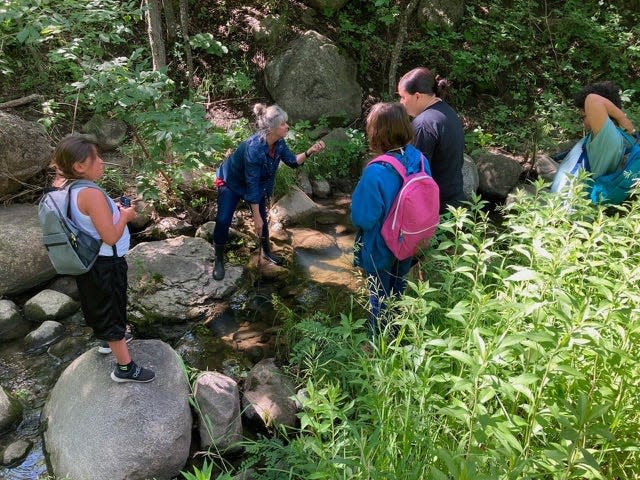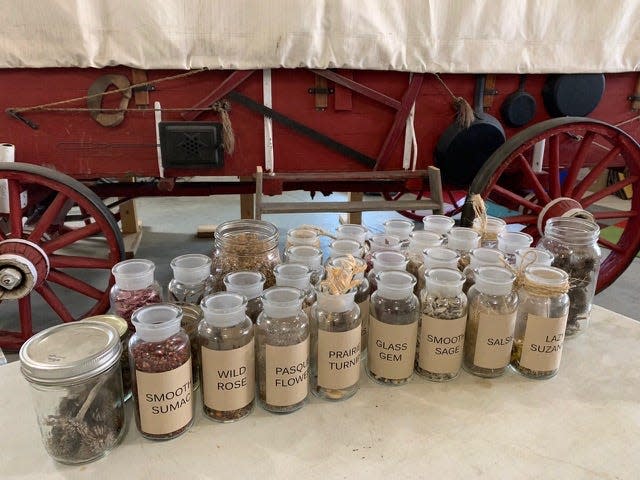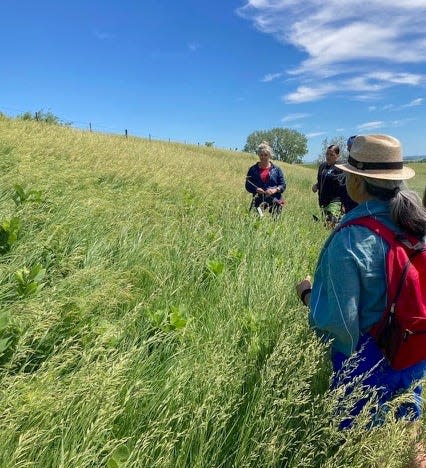Efforts to save diminishing South Dakota grassland earns Iowa native conservationist award

A 1,000-acre prairie restoration project has earned Tracy Rosenberg of Marvin the National Organization of Professional Women's Conservationist of the Year honor for 2022.
Since 2013, Rosenberg has worked hard to return her 1,000-acre prairie to its natural state. Her journey to this point has been won through determination, heartbreak and a deep love for conservation.
Before she became the steward of one of the last remaining acres of native sod, or acreage that had never been tilled for crop, in the country, Rosenberg lived the urban life in Des Moines for 35 years. But Rosenberg grew up on an Iowa farm and was no stranger to rural life and land management. She even had a small plot of farmland she intended to restore.
Her divorce stalled those conservation efforts, but it did not stop her from reaching for her dreams.
"I was forced to sell my farmland that was part of the property settlement," said Rosenberg. "I wanted to invest in property again, but this time I wasn't going to buy cropland. I started looking for grassland in Iowa."
Little grassland remains in Iowa
Unfortunately, Iowa has precious little native sod remaining. According to Tallgrass Prairie Center in Cedar Falls, Iowa, only one-tenth of 1% of native sod remains in Iowa. Rosenberg was coming up short in her hunt for grassland to purchase in her home state.
But an article in the Star Tribune, "Plowing away the prairie, for a price," gave her a contact that would forever change her life.

"When I read this article, I thought that it was the story of my life," said Rosenberg.
The article mentioned Pete Bauman, a prairie conservationist with the Nature Conservancy who works with landowners in Minnesota and across the Dakotas.
"I Googled Pete's name and found his e-mail. I mentioned the article and asked him if he had any leads on prairie that was for sale. Within an hour, I got an e-mail back from him that said, 'We need to talk as soon as possible,'" said Rosenberg.
Acreage found in Marvin
Bauman connected Rosenberg with the Blue Cloud Abbey in Marvin, which was looking to sell their land, including 1,000 acres of native sod used as pasture land for cattle.
"It was completely degraded when I first saw it," said Rosenberg. "It didn't even look like prairie. It just looked like a beat-up pasture."
With more than 250 head of cattle on the land and no water tanks, the prairie was filled with non-native vegetation, cattle trails and ruts. Despite the poor condition caused by overgrazing and mismanagement, Bauman assured Rosenberg that there was still hope in these acres of centuries-old grasses and wildflowers if treated correctly.
The most important way to preserve native sod is to protect it from tilling. Once it has seen a plow, those deep, ancient plant roots vital to biodiversity are gone, she said.
"If you use grassland management practices that are proven and manage rest periods, you can bring prairie back quite quickly. But you can't bring it back once the sod has been busted," said Rosenberg. "Once you flip that sod over, you will never get it back to prairie. In 100 years, you might get some reestablished ecosystems. But once you disturb that infrastructure underground, it will never heal to how it was before."
Although there was a delay in her ability to purchase the prairie from the Blue Cloud Abbey, Rosenberg was determined to begin her conservation efforts immediately. Despite no return on her investment, Rosenberg signed a two-year lease agreement on the land and got to work.
"In 2013, a month before my lease was up, they asked me to bring them an offer," said Rosenberg. "I presented a PowerPoint with how I intended to conserve the land. I was told they would think it over and asked me to go to the Chapel and pray. Not 30 minutes later, they came to me and told me they accepted my offer."
NRCS grant helped share cost of conservation efforts
Through a cost-share grant with the Natural Resources Conservation Service, Rosenberg has installed over 25 miles of interior cross-fence and 40 grazing cells. Two small herds of cattle are moved between the grazing cells every one to two days, preventing overgrazing and applying grazing pressures where needed.

The grazing cells also stop cattle from loitering in natural water sources, which protects the watershed and promotes biodiversity. Rosenberg also installed five miles of above-ground pipeline to supply water to multiple stock tanks.
"When I talk about biodiversity, it is more than just wildlife. It is the insects and the earthworm, the microbes and the fungi. This whole business that is going on in the soil is new knowledge for people," said Rosenberg.
The cost-sharing grant was spent within her first three years of operation, but Rosenberg's conservation efforts have not ceased. One of those self-funded projects was installing escape ramps inside her stock water tanks to prevent wildlife from drowning.
Although Rosenberg's operation costs are out of pocket, she rents her land to a cattle rancher and charges on a per day, per animal basis. This earns her the money necessary to continue restoration efforts. The 1,000 acres can support additional cattle, turning a greater profit, but Rosenberg knows that the restoration efforts and her patience means a greater return on her investments in the long run.
"I'm not making much money, but that isn't my goal," said Rosenberg. "My goal is to restore this landscape, and I'm not going to put capitalism over that right now. If I do, I will be selling myself short."
Rosenberg offers education opportunities
To help foster a deeper understanding and respect for the land, Rosenberg hosts prairie restoration presentations across the country. She also uses her acreage as an active classroom where children can learn by walking through the interpretive trail Rosenberg has built. Students can use their cellphones to scan QR codes found along the trail to learn about plants and wildlife while exploring the prairie.
She hopes that by exposing the younger generation of future farmers to conservation ranching, there may be a future for South Dakota grasslands.

"Conventional ranchers have been ranching in the same fashion as their fathers and grandfathers did. I am introducing a new concept because things are changing. We are losing our grasslands," said Rosenberg.
With concern across the region regarding carbon pipelines and extreme weather shifts, Rosenberg emphasizes the need for better education and more involvement in the conservation efforts she has begun on her land.
"Grasslands are a better carbon sink than a forest," she said. "Grass should be preserved the correct way, and better incentives to do that must be provided."
Winning the National Organization of Professional Women Conservationist of the Year has proven to Rosenberg that her efforts are making a difference. She hopes more women will hear her story and take their place among men on the boards and within organizations that help pass legislation in conservation.
"A pat on the back goes a long way. It shows that somebody notices and people are talking about this. Women are talking about this, and it's an award that went to a woman, not a man. I think women hardly get that nod," said Rosenberg.
This article originally appeared on Watertown Public Opinion: South Dakota woman wins conservationist award for prairie preservation

